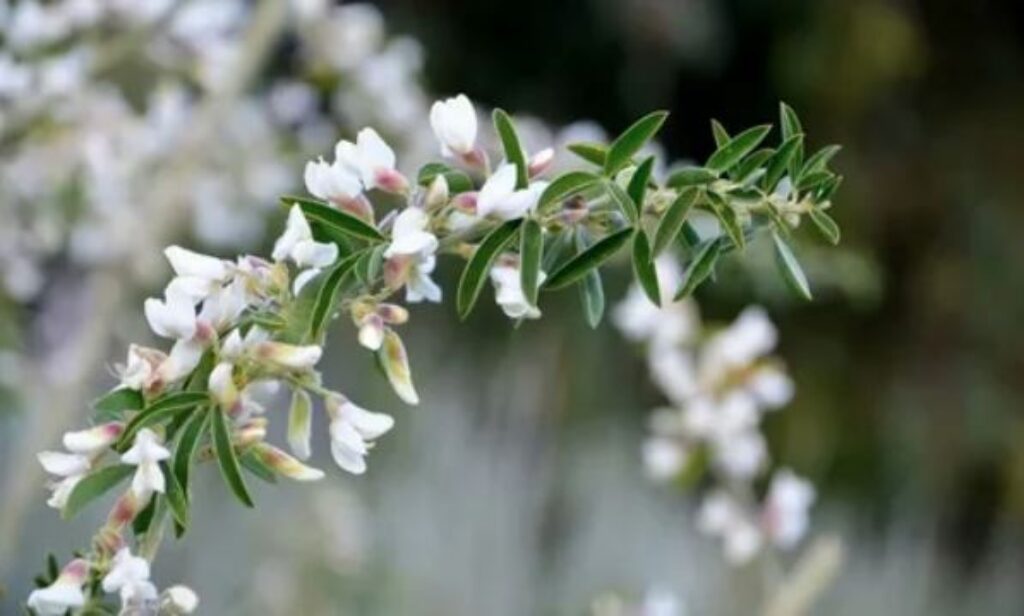Rosemary (Salvia Rosmarinus)
Rosemary is native to South America and is part of the mint and oreganofamily.It is commonly grown in homes for its aromatic, citrusy, and peppery flavor. Thisevergreen, drought-tolerant shrub remains green year-round. It featuresneedlelike, grayish-green leaves, and small blue or white flowers that bloominspringand summer. Rosemary can grow to a height of 2 to 6 feet within a fewyears.
Types of rosemary
Some famous types of rosemary are
- Salem Rosemary: This variety has fragrant blue flowersandsilver-green foliage.

- Chef’s Choice Rosemary: A smaller variety with evergreenleavesthat have a lemon flavor. It is cold-tolerant.

- Arp Rosemary: A rare variety with dark greenish-grayleavesthatemit an herbal fragrance.

- Prostrate Rosemary: Known for its dense leaves that spreadacross the ground.

- Golden Rain: This plant remains compact, growing to2to3feetin height and width, with yellow markings onits foliage.

- Albus: This variety produces white flowers.

Benefits of Rosemary
Rosemary contains anti-inflammatory, antioxidant, andantimicrobialcompounds. Historically, it has been used in both culinarypracticesand medicine.
1-High in antioxidant, antimicrobial, and anti inflammatory compounds
The Antioxidant Properties of Rosemary protect the bodyfromoxidative damage and help prevent diseases such as heart disease,cancer, and diabetes.
Rosemary leaves are used in medicine for this antibacterial. Itcanheal the wounds.
Rosemary’s antimicrobial properties make it an effectivenaturalpreservative. Its leaves are used in medicine for their antibacterialeffects, aiding in wound healing.
It has polyphenolic compounds like rosmarinic acidandcarnosicacid. Theses compounds have anti-inflammatory activity.
2-Nutrition
Rosemary is rich in phytochemicals. It contain
- Thiamin
- Riboflavin
- Pantothenic Acid
- Niacin
- Folate
Phytochemicals play a crucial role in combating diseaseandmaintaining overall health. They can improve vision, supportliverhealth, and reduce the risk of asthma.
3-Lower blood sugar
According to studies, rosemary tea can lower blood sugar levels. Thecarnosic acid and rosmarinic acid found in rosemary have insulin-likeeffects that help regulate blood sugar.
4-May improve your mood and memory
According to research rosemary oil lowered anxiety levels. It improvessleep quality. Just smelling rosemary improved mood, concentration,performance. Research suggests that rosemary oil canloweranxietylevels and improve sleep quality. Additionally, simplysmellingrosemary has been shown to enhance mood, concentration, andperformance
5- May support brain health
Rosemary tea may help protect brain health.
6-May promote digestion
Rosemary helps maintain a healthy balance of gut bacteriaandreduces inflammation, which supports good digestion.
7-May promote hair growth
Rosemary oil or extract can help reduce hair loss, makingitacommon ingredient in shampoos and medicinal products designedtoprevent hair loss.
8-Source of maganese
Rosemary contains a significant amount of manganese, which is beneficial formetabolic health. It helps the body form blood clots, aiding in faster healingofinjuries.
9-Immune System
Rosemary helps lower the risk of infection, thereby supporting and improvingtheimmune system.
Conditions suitable for rose marry/Is rose marry can be indoor plants? Where does rosemary like to grow?
Rosemary thrives in full sun, requiring at least 6-8 hours of direct sunlight each day, and prefers well-draining soil. Although it can adapt to various soil conditions, it does not tolerate water logged soil. Choose a planting spot that is protected from strong winds.
Is rose marry can be indoor plants?
Rosemary is not well suited for indoor plant. If you want tokeepitinside the home then don’t keep it in humid places like bathrooms,inA.c.
Place it in south facing window that receive enoughlight orterraceswhere it can receive 4-5 hour direct sunlight.
How to grow/propagate rosemary?
Media
Media that are used to propagate the rosemary is
1-Water:
Water is an effective medium for propagating rosemary. Topropagate,dip 2/3 of the stem in water and change the water if it becomesdirty.Roots will develop within about 3 weeks, after whichyoucantransferthe plant to soil.
2-Leca:
Leca (Lightweight Expanded Clay Aggregate) retainsmoistureeffectively. To propagate rosemary using LECA, place it inacontainer,add water, and insert the cut stem. After about 3 weeks, rootswilldevelop. You can then transfer the rooted steminto soil.
3-Mix soil:
you can also place rose marry cutting insoil. Forthisuse
Garden soil: 1 part
Cocopeat:1 part
Perlite:1/2 part
Sand:1/2 part
The soil should be well-drained, as rosemary prefersconditionssimilar to its desert origins and does not thrive in marshysoils. Waterthe plant only when the soil is dry. After about 3 weeks, whenrootshave developed, transfer the plant to a larger pot if therootshavegrown deep. The best seasons for propagating rosemaryarespringand the rainy season.
Garden Soil preparation
- Prepare the soil by removing all rocks, weeds, and debris.
- Test the soil to determine its pH and fertility.
- Add compost or organic matter if fertility or nutrient levelsarelow,and add lime if the pH is too low.
- . Create raised, mounded beds for good drainage.
- Cut an 8-10 inch branch from the plant.
- Remove the lower leaves from the cutting.
- Plant the cuttings 2-3 inches deep in the soil.
- Water the cuttings.
- Place the pot in a bright light.
Water the plant twice a week. After 4 weeks, roots will appear, andthe plant will begin to grow.

Rosemary propagationmethod
Rosemary can be propagated through
1-Stem cutting
2-seeds
Stem Cutting
How to take rosemary cuttings?
1-Take healthy cuttings from an health plant plant.
2-The cutting should be hard stem.
3-Cut a 10-15cm stem with, sharp plant scissors.
4-Remove the leaves from the lower side of stem it will reduce rot developing.
5-Put the cutting in media I.e water ,soil for rooting
How to care rose marryplant?
Light
Rosemary, with its desert origins, thrives in bright light andneedsatleast six hours of direct sunlight. If you keep rosemary indoors, placeit in a south-facing window. During warmweather, moveindoorplants outside to expose them to natural sunlight.
Temperature and Humidity
Rosemary thrives in warm weather. Most varieties cantoleratetemperatures as low as 50 degrees Fahrenheit, but they growbestataround 30 degrees. Temperatures below 20 degrees canstunt growth.Rosemary requires normal humidity levels, as high humiditycanleadto rot.
Soil
Soil should be well-drained, as marshy or wet soil cancauserootrot.Use sandy or loamy soil for best results. Rosemary grows well inwell-draining soil with a slightly acidic to neutral pH, ideally between6.0and 7.0.
Water
Rosemary, with its desert origins, is drought-tolerant anddoesn’trequire much water. Water it once a week, or whenthesoil isdry.Avoid overwatering, as excess moisture can harmthe plant.
Pollination
Rosemary flowers attract bees and other pollinators. Tobenefitfromthis, keep the plant outside when its flowers are opento drawinthesebeneficial insects
Fertilizer
Rosemary does not require much fertilization. Mixing compostintothe soil at the time of planting is typically sufficient for its growth
Pruning
Pruning helps prevent the plant frombecoming woodyandencourages new growth. It is essential for maintaining thehealthandshape of shrub-like plants
Common problemfor rosemarry
1-Fungul
2-Bacterial
1-Fungul
If a plant suddenly starts dying, dries out, and turns yellow, it maybeinfected by cottony soft rot caused by Sclerotinia sclerotiorum. Thisfungal infection, which is a result of high humidity, canbeobservedas small fungal growths on the surface of the roots. Onceinfected,itis challenging to save the plant. Discard the infected plant andavoidreplanting rosemary in the same soil, as it may be contaminated.Always use healthy plants for new rosemary plantings inyourgardenor pot.

If the leaves start yellowing and show a downy growth, it maybedueto downy mildew caused by the fungus Peronosporalamii. Highhumidity promotes this fungal infection.
To prevent fungal infections like downy mildew, ensuregoodaircirculation around the plants. Avoid placing themin moist areassuchas bathrooms or near fountains. Instead, keep the plant inadrylocation with low humidity.
2-Bacterial
If you notice ball-like growths on the roots, the plant may be infectedbythebacterium Agrobacterium tumefaciens. These galls can also appear onthestems. In advanced stages, the infection can girdle the stem, leading totheplantdrying out and eventually dying. This soil-borne infection enters throughwoundsin the plant. To address this issue, use healthy, sterilized soil and avoidinjuringthe plants. Discard any infected plants to prevent further spread.
Frost Damage
Rosemary cannot tolerate low temperatures and will not survivefrost.In cold weather, it may shrivel and turn brown. To protect it, keeptheplant indoors during winter.
High temperature
Temperatures above 37°C (99°F) can be harmful to rosemary. Hightemperaturesmay cause leaf burn and affect growth. To mitigate these effects, keepthesoilmoist and maintain adequate humidity.
Not Enough Sunlight
In shady or dark places, rosemary may lose its fragrance, andtheleaves can turn dark and yellow. Additionally, the plant maynotproduce flowers. To keep rosemary healthy, ensure it receivesadequate sunlight.
Acidic Soil pH
A low soil pH can cause the plant to turn yellowand start dying, asitinhibits the uptake of minerals and nutrients. To correct this, addlime to balance the pH.
Too Much Nitrogen
Rosemary does not require much fertilization. Over-fertilizingcanleadto nutrient imbalances and excessive growth. For natural growth,it’sbest to avoid adding fertilizer.







